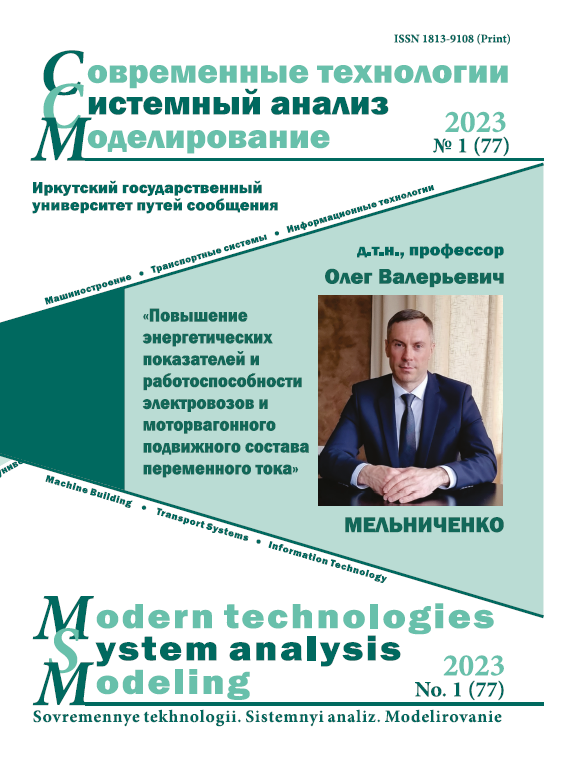Increasing the throughput capacity of the Slyudyanka-1 - Ulan-Ude section by building an optimal train traffic model
Keywords:
interval control systems, flow models, train schedule, ABTTs-MSh, reduction of intervals between trains, section Slyudyanka-1 – Ulan-UdeAbstract
The development of new approaches to increasing the throughput in railway transport has been and remains one of the main tasks, which is receiving quite a lot of attention at the present time. In modern conditions, in order to strengthen the throughput and carrying capacity, it is important to tighten the traffic schedule, make fuller use of the existing infrastructure and technical means, use modern intelligent control systems and other organizational and technical solutions aimed at processing and forming a larger number of car traffic and train traffic. The article proposes to consider and simulate the operation of the Slyudyanka-1 – Ulan-Ude section during the implementation of interval train control systems and determines the possibility of passing a larger number of trains as compared to the existing technology. To increase the capacity on the section Slyudyanka-1 – Ulan-Ude, the possibility of using ABTC-MSh is considered as such a system. Modeling the work of the section consists in the development of an algorithm and the construction of flow models reflecting the arrival and departure of trains at the main stations of the section, which makes it possible to identify time reserves in the departure of a larger number of trains. Based on the results of modeling and calculations, a list of train flows of the section is formed, a proposed train schedule is built and its indicators are calculated. At the end of the article, a conclusion is made about the prospects for the application of innovative technologies in the field of interval control of train traffic on the Slyudyanka-1 – Ulan-Ude section and practical recommendations are given.
References
Долгосрочная программа развития ОАО «РЖД» до 2025 года : распоряжение Правительства Рос. Федерации от 19.03.2019 № 466 (ред. 13.10.2022). URL : http://publication.pravo.gov.ru/Document/View/0001201903210017 (Дата обращения 20.01.2023).
О вводе в действие типового технологического процесса управления местной работой : распоряжение ОАО «РЖД» от 15.04.2016 г. № 684р (ред. 25.07.2022). Доступ из справ.-прав. системы «АСПИЖТ» в локальной сети.
Прокопьева Е.С., Фомин С.А., Панин В.В. Определение станционных и межпоездных интервалов при интервальном регулировании движения поездов // Железнодорожный транспорт. 2017. №7. С. 20–23.
ОАО «РЖД» продолжит внедрение технологий интервального регулирования // АВП Технология : сайт. URL : https://avpt.ru/news/oao-rzhd-prodolzhit-vnedrenie-tekhnologiy-intervalnogo-regulirovaniya/ (Дата обращения 16.02.2023).
Розенберг Е.Н., Аношкин В.В. Перспективы роста пропускной способности участка // Железнодорожный транспорт. 2020. № 3 С. 4–7.
Белькова Ю.Д., Симоченко А.С., Белоголов Ю.И. Современные системы интервального регулирования движения поездов // Молодая наука Сибири. 2021. № 2 (12). С. 97–102.
Кондратьева Л.А. Системы регулирования движения на железнодорожном транспорте. М. : УМЦ по образованию на ж.-д. трансп., 2016. 322 с.
Белоголов Ю.И., Стецова Ю.М., Оленцевич А.А. Использование методов математического моделирования при управлении транспортными процессами на железной дороге // Транспортная инфраструктура Сибирского региона : материалы девятой Междунар. науч.-практ. конф. Иркутск, 2018. Т.1. С. 145–148.
Белькова Ю.Д., Белоголов Ю.И. Построение графика движения поездов для участка Слюдянка I – Улан-Удэ при внедрении АБТЦ-МШ // Молодая наука Сибири. 2021. № 3 (13). С. 109–117.
Development of the performance control algorithm of the blower motors of electric locomotives for various operating modes / A.R. Akhmetshin, K.V. Suslov, N.P. Astashkov et al. // Actual Issues of Mechanical Engineering (AIME 2020) : IOP Conference Series: Materials Science and Engineering. Saint-Petersburg, 2020. DOI 10.1088/1757-899X/1111/1/012001.
Левин Д.Ю. Диспетчерские центры и технология управления перевозочным процессом. М. : Маршрут, 2005. 760 с.
Абрамов А.А. Управление эксплуатационной работой. Ч. II. График движения поездов и пропускная способность. М. : РГОТУПС, 2002. 171 с.
Макаров Н.М. Анализ систем интервального регулирования // Труды 79-ой студ. науч.-практ. конф. РГУПС. Воронеж, 2020. Т. 3. С. 39–41.
Долгий А.И. Концептуальный подход к построению современной платформы управления перевозочным процессом в ОАО «РЖД» // Труды АО «НИИАС». 2021. Т. 1. Вып. 11. С. 9–31.
Ратобыльская Д.В. Пути повышения пропускной способности участков железнодорожной сети на основе имитационного моделирования // Математические машины и системы. 2010. № 2. С. 116–121.
Румянцев С.В. Технические средства интервального регулирования // Локомотив. 2019. № 5. С. 39–42.
Системы железнодорожной автоматики, телемеханики и связи (в 2 ч.) / Ю.Г. Боровков, Д.В. Шалягин, А.В. Горелик и др. М. : УМЦ по образованию на ж.-д. трансп., 2012.
Никитин Д.А. Повышение информативности системы интервального регулирования движения поездов АЛС-ЕН путём использования модульно взвешенного кода с суммированием // Автоматика на транспорте. 2017. Т. 3. № 4. С. 526–545.
Оленцевич В.А., Власова Н.В. Оптимизация работы железнодорожных станций Восточного полигона в условиях внедрения современных систем организации движения поездов // Управление эксплуатационной работой на транспорте : сб. тр. междунар. науч.-практ. конф. СПб., 2022. С. 103–108.


